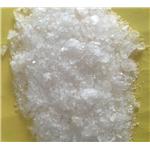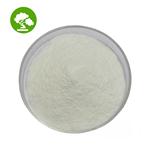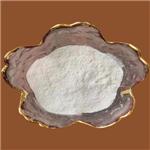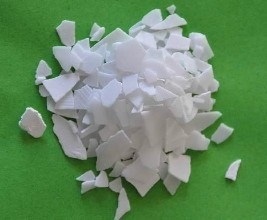- Potassium hydroxide
-

- $1.00 / 25kg
-
2024-04-24
- CAS:1310-58-3
- Min. Order: 1kg
- Purity: 99%
- Supply Ability: 1000mt/year
- Potassium hydroxide
-

- $0.00 / 25kg
-
2024-04-12
- CAS:1310-58-3
- Min. Order: 1kg
- Purity: 99%
- Supply Ability: 2000ton
- Potassium hydroxide
-

- $16.00 / 1KG
-
2024-01-18
- CAS:1310-58-3
- Min. Order: 2600KG
- Purity: 99%
- Supply Ability: 20T
Related articles - Introduction of Potassium hydroxide
- Potassium hydroxide is an inorganic compound which is denoted by the chemical formula KOH. Potassium hydroxide is also known a....
- Feb 28,2022
- Uses of Potassium hydroxide
- Potassium hydroxide is an inorganic compound with the formula KOH, and is commonly called caustic potash.
- Dec 24,2021
|
| | Potassium hydroxide Chemical Properties |
| Melting point | 361 °C (lit.) | | Boiling point | 1320°C | | density | 1.450 g/mL at 20 °C | | vapor pressure | 1 mm Hg ( 719 °C) | | refractive index | n20/D 1.421 | | Fp | 52 °F | | storage temp. | Store at +5°C to +30°C. | | solubility | H2O: 1 M at 20 °C, clear, colorless | | form | powder | | Specific Gravity | 1.09 | | color | white | | Odor | Odorless | | PH | 10.98(1 mM solution);11.95(10 mM solution);12.88(100 mM solution); | | explosive limit | 3.5-15.0%(V) (ethanol) | | Water Solubility | soluble | | Sensitive | Air Sensitive & Hygroscopic | | Merck | 14,7640 | | Exposure limits | Ceiling in air 2 mg/m3 (ACGIH). | | Dielectric constant | 3.3(Ambient) | | Stability: | Stable, but very hygroscopic. Dissolves exothermically in water. Incompatible with most metals, strong acids, acid chlorides, organic materials, zinc, aluminium, nitroalkanes, nitrobenzene, chlorine dioxide. Reacts vigorously with a wide variety of other materials. Readily absorbs water and carbon dioxide from the air. | | InChIKey | KWYUFKZDYYNOTN-UHFFFAOYSA-M | | LogP | -1.380 (est) | | CAS DataBase Reference | 1310-58-3(CAS DataBase Reference) | | NIST Chemistry Reference | Potassium hydroxide(1310-58-3) | | EPA Substance Registry System | Potassium hydroxide (1310-58-3) |
| | Potassium hydroxide Usage And Synthesis |
| Description | Potassium hydroxide(KOH) is highly basic, forming strongly alkaline solutions in water and other polar solvents. These solutions are capable of deprotonating many acids, even weak ones.
Potassium hydroxide is used to make soft soap, in scrubbing and cleaning operations, as a mordant for woods, in dyes and colorants, and for absorbing carbon dioxide. Other principle uses of caustic potash are in the preparation of several potassium salts, acid-base titrations, and in orgainic sytheses.

Also, KOH is an electrolyte in certain alkaline storage batteries and fuel cells. Potassium hydroxide is used in neutralization reactions to yield potassium salts. Aqueous potassium hydroxide is employed as the electrolyte in alkaline batteries based on nickel-cadmium and manganese dioxide-zinc. Alcoholic KOH solutions are also used as an effective method for cleaning glassware. KOH works well in the manufacture of biodiesel by catalyzing transesterification of the triglycerides in vegetable oil.
| | Chemical Properties | Pure potassium hydroxide is a solid at room temperature, though it is often sold as a liquid. Potassium hydroxide is a strong alkaline substance that dissociates completely in water into the potassium ion (K+) and hydroxide ion (OH-). The dissolution in water generates heat, so a vigorous reaction can occur when potassium hydroxide is added to water. The vapor pressure of the substance is very low and the melting point is high. Potassium hydroxide solutions attack aluminium and its alloys under formation of hydrogen gas. It can be neutralised with acids (e.g. hydrochloric acid) giving the corresponding potassium salts of the acids, which are usually pH neutral and non-corrosive.
| | Uses | Potassium hydroxide has many different functions and uses.
- It is primarily used as an intermediate in industrial manufacturing processes, such as the manufacture of fertilisers, potassium carbonate or other potassium salts and organic chemicals.
- It is also used in the manufacture of detergents and in alkaline batteries.
- Small-scale uses include drain cleaning products, paint removers and degreasing agents.
- manufacture of liquid soap;
- mordant for wood;
- absorbing CO2;
- mercerizing cotton;
- paint and varnish removers;
- electroplating, photoengraving and lithography;
- printing inks;
- in analytical chemistry and in organic syntheses.
- Pharmaceutic aid (alkalizer).
| | Applications |
Industry
Application
Role/benefit
Chemical manufacturer
Manufacturer of other potassium compounds
Precursor/source of potassium
Electrochemistry
Manufacture of batteries and fuel cells
Electrolyte/ good conductors of electricity
Wet processing of semiconductors
Etchant/corrosivity and alkalinity
Biomass fuels
Manufacturing biodiesel from oils and fats
Catalyst/KOH works well in the manufacture of biodiesel by transesterification of the triglycerides in vegetable oil
Food
Rinse or chemical peel for fruits and vegetables
Additive in rinse solution/corrosivity and alkalinity
Chocolate,cocoa,soft drink,ice cream,etc.
Stabilizer,thickener and pH regulator
Cleaning
Manufacture of "potassium soaps"
Saponification agent/has better softness and greater solubility than sodium soaps
Industrial cleaners for oven,drain,driveway,concrete,pipe,etc.
Additive/alkalinity and good solubility for grease
Liquid soaps, lotions, shampoos, hairsprays, and denture cleaners
Additive/helps to increase softness and solubility
Medicine
Disbudding calves horns and dissolving scales and hair in veterinary medicine
Dissolving solution/good solubility for keratin
Dissolving warts and cuticles in humans
Diagnose fungal infections
Diagnose agent
Production of potassium boron hydrogen, spironolactone, progesterone and testosterone propionate, etc.
Raw material
Agriculture
Potassium fertilizers (potassium phosphate)
Raw material/source of potassium
Paper
Separation of lignin from cellulose fibers
Additive/alkalinity
Dyeing
Manufacture of tripolycyanamide dye
Raw material
Textile
Dyeing, bleaching and mercerizing textiles
Additive/corrosivity and alkalinity
Manufacture of artificial fiber and polyester fiber
Main raw material
Chemical analysis
Titration of acids
Titration agent/alkalinity
Others
Bleaching textiles
Bleaching agent
Absorption of CO2, SO3 and NO3 in gas streams
Absorption agent/alkalinity
Absorption of H2O
Absorption agent/ hygroscopicity of anhydrous potassium hydroxide
| | Production Methods | Potassium hydroxide is produced commerically by electrolysis of a saturated solution of potassium chloride in brine using mercury cells consisting of a titanium anode and mercury cathode. Potassium reacts with mercury forming the amalgam which, on treatment with water, forms potassium hydroxide and hydrogen.
Other types of electrolytic cells, although not so commonly used today, are also known. In a diaphragm type cell that separates the cell into anode and cathode compartments, an aqueous solution of potassium chloride is electrolyzed. Potassium hydroxide and hydrogen are produced at the cathode and chlorine is liberated at the anode. The solution discharged from the cell is evaporated to concentrate potassium hydroxide and precipitate potassium chloride.
Potassium hydroxide also may be made by reacting potassium superoxide with water:
2KO2 + 2H2O → 2KOH + H2O2 + O2
| | Reactions | Potassium hydroxide is a very strong base, more basic than caustic soda. It is neutralized by acids. The solution on evaporation yields the corresponding potassium salt:
KOH + HCl → K+ + Cl¯+ H2O
Action of bromine or iodine on a warm concentrated solution of KOH forms bromate and bromide or iodate and iodide, respectively:
3Br2 + 6OH¯→ BrO3¯ + 5Br¯ + 3H2O
3I2 + 6OH¯ → IO3¯ + 5I¯ + 3H2O
When carbon dioxide is passed through its aqueous solution and the solution evaporated, potassium bicarbonate is formed:
KOH + CO2 → KHCO3
Reaction with carbon monoxide at 100 to 200°C at a CO pressure above 7 atm yields potassium formate:
KOH + CO → HCOOK
Reaction with phenol in dilute methanol solution forms potassium phenoxide:
KOH + C6H5OH → C6H5OK + H2O
Reaction with boric acid and hydrofluoric acid forms potassium tetrafluoroborate, KBF4:
KOH + H3BO3 + 4HF → KBF4 + 4H2O
An alcoholic solution of potassium hydroxide reacts with an alcoholic solution of carbon disulfide to form potassium ethylxanthogenate, C2H5OCS2K
KOH + C2H5OH + CS2 → C2H5OCS2K + H2O
Reaction with sodium borohydride forms potassium borohydride:
POTASSIUM HYDROXIDE 759KOH + NaBH4 → KBH4 + NaOH
Reaction with hydrofluoric acid forms potassium bifluoride:
KOH + 2HF → KHF2 + H2O
Half neutralization of a phthalic anhydride solution forms potassium hydrogen phthalate.
| | Chemical Properties | Potassium hydroxide occurs as a white or nearly white fused mass. It is available in small pellets, flakes, sticks and other shapes or forms. It is hard and brittle and shows a crystalline fracture. Potassium hydroxide is hygroscopic and deliquescent; on exposure to air, it rapidly absorbs carbon dioxide and water with the formation of potassium carbonate. Soluble in water, alcohol, glycerol; slightly soluble in ether. | | Uses | Potassium Hydroxide is a water-soluble food additive and bleaching
agent. upon exposure to air it readily absorbs carbon dioxide and
moisture and deliquesces. it is used to destroy the bitter chemical
constituents in olives that will be used as black olives. | | Indications | Potassium hydroxide (KOH) is a strong alkali that digests proteins and epidermal
debris. In one study, 10% solution was applied b.i.d. to each lesion for 30 days with excellent clearance. The side effects included stinging of the lesion and one case of secondary infection. Also reported were the occurrence of a hypertrophic scar
as well as some persistent or transitory hyper- and hypopigmentation. The same
authors who used the 5% KOH solution completed further studies and they found
it to be as effective-yet with decreased side effects. | | Production Methods | Potassium hydroxide is made by the electrolysis of potassium
chloride. Commercial grades may contain chlorides as well as other
impurities. | | Application | Potassium hydroxide is used as an emulsifier in lotions and as an alkali in liquid soaps, protective creams, and shaving preparations. Depending on the concentration used, it can be highly irritating to the skin and/or cause a burning sensation. It is used in making potassium salts, in electroplatingand lithography, in printing inks, as a mordantfor wood, and finds wide applicationsin organic syntheses and chemical analyses. | | Definition | ChEBI: Potassium hydroxide is an alkali metal hydroxide. | | General Description | A white solid. Corrosive to metals and tissue. Used in soap manufacture, bleach, as an electrolyte in alkaline batteries, and as a food additive. | | Air & Water Reactions | Hydrolysis generates enough heat to ignite adjacent combustible material [Haz. Chem. Data 1966]. Dissolves in water (with liberation of heat, may steam and spatter. Solution is basic (alkaline). Deliquescent | | Reactivity Profile | POTASSIUM HYDROXIDE absorbs moisture readily forming caustic solution that attacks aluminum and zinc. A piece of potassium hydroxide causes liquid chlorine dioxide to explode [Mellor 2:289. 1946-47]. 1,2-dichloroethylene and potassium hydroxide forms chloroacetylene, which is explosive and spontaneously flammable in air. Potassium hydroxide is highly toxic [Rutledge 1968. p. 134]. A reaction between n-nitrosomethylurea and potassium hydroxide in n-butyl ether resulted in an explosion due to the formation of diazomethane [Schwab 1972]. Potassium persulfate and a little potassium hydroxide and water ignited a polythene (polyethylene) liner of a container by release of heat and oxygen [MCA Case History 1155. 1955]. Using potassium hydroxide to dry impure tetrahydrofuran, which contains peroxides, may be hazardous. Explosions have occurred in the past. Sodium hydroxide behaves in a similar way as potassium hydroxide [NSC Newsletter Chem. Soc. 1967]. A strong base. Forms caustic solution in water. [Merck 11th ed. 1989]. | | Health Hazard | Toxic by ingestion and inhalation, strong caustic, handle with gloves or tongs, corrosive to tissue. Eye, skin and upper respiratory tract irritant.
Potassium hydroxide is a strongly alkaline, hydrophilic substance and therefore solid potassium hydroxide is highly corrosive. It reacts with fat and can cause irreversible damage to any site of contact with the body (for example skin or eyes). Solutions of potassium hydroxide in water at concentrations above 0.5% (w/w) are irritating at points of contact and, at higher concentrations, the solutions can be corrosive. Potassium hydroxide does not cause skin allergies. Because of the corrosive properties of potassium hydroxide, its ingestion can be fatal. Under normal conditions of handling and use, potassium hydroxide in solution will dissociate into its constituent ions and, if ingested, will not be systemically available in the body as such. | | Fire Hazard | Non-combustible, substance itself does not burn but may decompose upon heating to produce corrosive and/or toxic fumes. Some are oxidizers and may ignite combustibles (wood, paper, oil, clothing, etc.). Contact with metals may evolve flammable hydrogen gas. Containers may explode when heated. | | Flammability and Explosibility | Sodium hydroxide and potassium hydroxide are not flammable as solids or aqueous
solutions. | | Pharmaceutical Applications | Potassium hydroxide is widely used in pharmaceutical formulations
to adjust the pH of solutions. It can also be used to react with weak
acids to form salts.
Therapeutically, potassium hydroxide is used in various
dermatological applications. | | Safety Profile | Poison by ingestion. An
eye irritant and severe human skin irritant.
Very corrosive to the eyes, skin, and mucous
membranes. Mutation data reported.
Ingestion may cause violent pain in throat
and epigastrium, hematemesis, collapse.
Stricture of esophagus may result if
substance is not immedately fatal. Above
84' it reacts with reducing sugars to form
poisonous carbon monoxide gas. Violent,
exothermic reaction with water. Potentially
explosive reaction with bromoform + crown
ethers, chlorine dioxide, nitrobenzene,
nitromethane, nitrogen trichloride,
peroxidized tetrahydrofuran, 2,4,6-
trinitrotoluene. Reaction with ammonium
hexachloroplatinate(2-) + heat forms a heat-
sensitive explosive product. Violent reaction
or ignition under the appropriate condtions
with acids, alcohols, p-bis(l,3-
dbromoethyl)benzene, cyclopentadene,
germanium, hyponitrous acid, maleic
anhydride, nitroalkanes, 2-nitrophenol,
potassium peroxodisulfate, sugars, 2,2,3,3-
tetrafluoropropanol, thorium dicarbide.
When heated to decomposition it emits
toxic fumes of K2O. See also SODIUM
HYDROXIDE. | | Safety | Potassium hydroxide is widely used in the pharmaceutical and food
industries and is generally regarded as a nontoxic material at low
concentrations. At high concentrations it is a corrosive irritant to
the skin, eyes, and mucous membranes.
(rat, oral): 0.273 g/kg | | Potential Exposure | KOH is generally used as an alkali
and in the manufacture of other potassium compounds. | | storage | splash goggles and impermeable gloves should be worn at all times when handling these substances to prevent eye and skin contact. Operations with metal hydroxide solutions that have the potential to create aerosols should be conducted in a fume hood to prevent exposure by inhalation. NaOH and KOH generate considerable heat when dissolved in water; when mixing with water, always add caustics slowly to the water and stir continuously. Never add water in limited quantities to solid hydroxides. Potassium hydroxide should be stored in an airtight, nonmetallic container in a cool, dry place, separated from acids and incompatible substances. | | Shipping | UN1814 (solution) & UN1813 (solid); Potassium
hydroxide, solid or solution, Hazard class: 8; Labels:
8-Corrosive material. | | Purification Methods | Its carbonate content can be reduced by rinsing KOH sticks rapidly with water prior to dissolving them in boiled out distilled water. Alternatively, a slight excess of saturated BaCl2 or Ba(OH)2 can be added to the solution which, after shaking well, is set aside so that the BaCO3 is allowed to separate out. Davies and Nancollas [Nature 165 237 1950] rendered KOH solutions carbonate free by ion exchange using a column of Amberlite IR-100 in the OH-form. | | Incompatibilities | Potassium hydroxide is a strong base and is incompatible with any compound that readily undergoes hydrolysis or oxidation. Violent reaction with acids, alcohols, water, metals (when wet), halogenated hydrocarbons; maleic anhydride. Heat is generated if KOH comes in contact with water and carbon dioxide from the air. It should not be stored in glass or aluminum containers, Corrosive to zinc, aluminum, tin and lead in the presence of moisture releasing combustible/explosive hydrogen gas. Can absorb water from air and give off sufficient heat to ignite surrounding combustible materials. | | Waste Disposal | Dilute with large volume of
water, neutralize and flush to sewer | | Regulatory Status | GRAS listed. Accepted for use in Europe in certain food
applications. Included in the FDA Inactive Ingredients Database
(injections, infusions, and oral capsules and solutions). Included in
nonparenteral and parenteral medicines licensed in the UK.
Included in the Canadian List of Acceptable Non-medicinal
Ingredients. |
| | Potassium hydroxide Preparation Products And Raw materials |
| Raw materials | Sodium hydroxide-->Hydrochloric acid-->Potassium carbonate-->Hydrogen-->Potassium chloride-->Graphite-->Potassium hydroxide solution-->Potassium fluoride-->Barium chloride dihydrate-->Barium chloride-->Mercury-->Potassium amalgam | | Preparation Products | 2-Amino-4-trifluoromethylbenzonitrile-->2,3-Dimethylthiophene-->Vat Grey M-->Antistatic agent PK-->Potassium sorbate-->Potassium fluoroaluminate-->GELLAN GUM-->2,3-Dimethylpyrazine-->2-BROMO-6-(1H-PYRAZOL-1-YL)PYRIDINE-->5-Hydroxymethyluracil-->4-ISOPROPOXYBENZOIC ACID-->1,2,3,4-TETRAHYDRO-9H-PYRIDO[3,4-B]INDOLE-->PYRROLIDONE HYDROTRIBROMIDE-->3,5-DIBROMO-2-ETHOXYBENZALDEHYDE-->3-ACETYL-2-METHYL-QUINOLINE-4-CARBOXYLIC ACID-->4-(CYCLOHEXYLTHIO)-3-NITROBENZALDEHYDE-->antistatic agent F695-->POLYETHYLENE GLYCOL MONOOLEYL ETHER-->1,2,3-Propanetricarboxylicacid,2-hydroxy-,potassiumsalt-->Potassium isobutylxanthate-->Potassium tartrate-->Potassium Amylxanthate-->4-(4-CHLOROPHENYLTHIO)-3-NITROBENZALDEHYDE-->4-[(2-FURYLMETHYL)THIO]-3-NITROBENZALDEHYDE-->4-(BENZYLTHIO)-3-NITROBENZALDEHYDE-->2-(2,4-DINITROPHENOXY)ETHANOL-->Piperonylic acid-->Potassium Citrate-->Organosilicon water-proofing agent-->4-ETHOXYPHENYLACETIC ACID-->2-Benzylaminopyridine-->Potassium stearate-->Potassium titanium oxalate-->oxalic acid, potassium salt-->Potassium hydrogen phthalate-->D-Glucosamine hydrochloride-->2-Allylcyclohexanone-->Potassium metavanadate-->potassium silicate,electronic grade-->Potassium lactate |
|